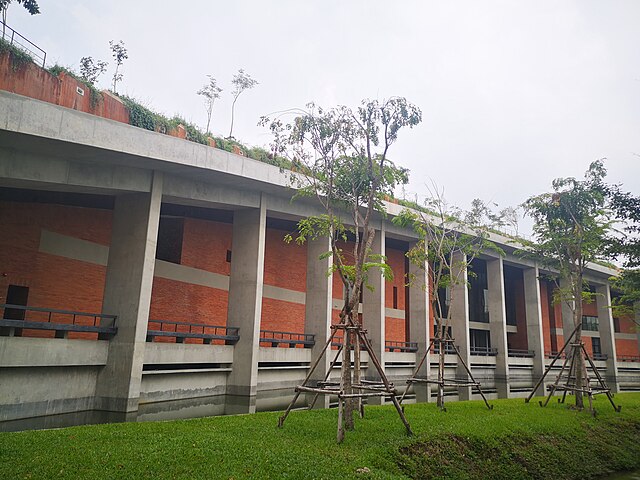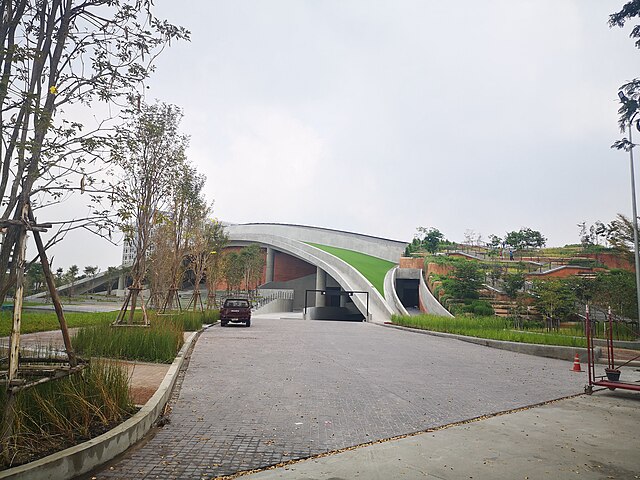
The official Thammasat University Facebook page has announced that the Thammasat University Urban Rooftop Farm at Puey Park has won an Architizer A + architectural award, among other honors.
The Puey Ungphakorn Centenary Hall and Park building was built on the occasion of the 100th anniversary of Professor Puey Ungphakorn in 2016. The roof of the building was designed as an organic vegetable garden and sky park, the largest in Asia.
The Thammasat University Library collection includes books about landscape architecture and urban gardens as well as urban farms.
According to its website, the Architizer A+Awards
are focused on promoting and celebrating the year’s best architecture and products. Its mission is to nurture the appreciation of meaningful architecture in the world and champion those products that are integral to bringing great buildings to life.
The Thammasat University Urban Rooftop Farm has a total area of 60,000 sq.m. (36 rai) with a green roof of 22,000 sq.m. (14 rai).
To complete the project in terms of master planning and landscape architecture, the landscape architect was LANDPROCESS, with architectural design by the Arsom Silp Institute of the Arts and interior design by Dimensional Interpretation, with structural engineering by Degree System Co., Ltd. and mechanical, electrical and plumbing (MEP) engineering by TPM Consultants Co., Ltd. The graphic designer was Be Our Friend studio.
As its online description explains,
Amidst the climate crisis, food and water scarcity pose tremendous threats to human civilization. Once abundant agrarian societies rich with food sources, Bangkok and cities across Southeast Asia are victims of unregulated urbanization on rice-producing regions. The once fertile marshlands have transformed into paralyzed concrete developments—no longer able to breathe, absorb water or grow food. To revive the land on which it stands, the Thammasat Urban Rooftop Farm (TURF) unites principles of modern landscape design with traditional agriculture of rice terraces, to transform wasted space into a productive organic rooftop farm—Asia’s largest.
Inspired by traditional agricultural practices on mountainous terrains across Southeast Asia, TURF’s landscape architect integrated the earthwork of rice terraces with modern green roof technology. The 236,806 sq. ft. cascading rooftop can slow down runoff up to 20 times more efficiently than a conventional concrete rooftop.
As rainwater zigzags down the slopes, each level of TURF harvests runoff from the previous cell, forming unique clusters of micro-watersheds along the terrace to helping absorb, filter and purify rainwater while growing food for the campus. By the end of its journey, four retention ponds await on each wing, capable of holding up to 3,095,570 gallons of water once combined. These ponds significantly reduce the volume of stormwater leaving the site while mitigating unexpected flood and drought disasters. They present a solution to storing excessive runoff during intense storms for future use during dry spells.

One landscape architecture critic observed,
Bangkok and cities in Southeast Asia are among the most vulnerable to climate impacts in the world. Victims of their own rapid development, unchecked industrialization urbanization on rice-producing societies. Unpredictable extremely wet and dry weather is now the new normal, causing flooding, damaging agriculture, destroying livelihoods, and threatening millions of people. Meanwhile, formerly fertile and productive, agricultural lands across Thailand have been converted into industrialized farms which not only pollute natural ecosystems, but also disregard public health and income equality…
But just a short trip away, a new integrative solution at Thammasat University (TU) has emerged to create climate resiliency, demonstrating how development can contribute more solutions than the problems it has created by embracing landscape architecture and past agricultural practices. As the largest urban rooftop farm in Asia, the 22,000 sq. m. (236,806 sq. ft.) Thammasat University Green Roof tackles climate impacts by incorporating modern landscape architecture with traditional agricultural ingenuity, the green roof, urban farming, solar roof and green public space.
The project combines the elements of ‘architecture’ and ‘landscape architecture’ so seamlessly that it is almost impossible to categorize what type of work it actually is. The form of the building is developed from the H-shaped floor plan, rendering the elevation that resembles a large mountain with a massive green space of garden covering upper part.
By mimicking traditional rice terraces, Thammasat University Urban Farming Green Roof has become an all-in-one solution–as a public green space, urban organic food source, water management system, energy house, and outdoor classroom–which serves as an adaptation model for anticipated climate impacts that can be implemented and developed across Thailand and Southeast Asia.
A century ago, the peri-urban of Bangkok, the Rangsit field once filled with paddy fields and swamps, envisioned by King Rama 5 to be the most productive rice-farming area in the world. But after years of unstoppable urban sprawl, the marshlands have turned to paralyzed concrete cities, no longer able to breathe, absorb water, or grow food. To revive the land on which it stands on, Thammasat University, one of Thailand’s leading universities, has created the innovative architecture by transforming an unused rooftop into a solution to climate, food, and pollution crisis.
Inspired by local ingenuity and traditional agricultural practices, the Thammasat University Urban Farming Green Roof’s cascading farm levels form a detention lawn which slows down, absorbs and stores rainwater while using it to grow food. Any runoff is filtered through each layer of soil and later saved up in four retention ponds, which can collect the water up to 11,718 Cubic meters (3,095,570 gallon) for rooftop irrigation and future use
To restore biodiversity back to the swamplands, The native plant strains grown on the farm creates a microclimate and attracts pollinator bird and insect species. As the plants on the Thammasat University Green Roof breathe, the oxygen and moisture they release helps build a stable microclimate for the animals to take refuge.
During heavy rainfalls, abundant soil mass and nutrients can be lost in along with the runoff. But with cascading layers of planters, the plants on the Thammasat University Green Roof hold the soil together and slowdown runoff. By embracing not only the intention of organic, but also regenerative agriculture, it ensures a food source beneficial to both the health of humans and nature…
LANDPROCESS is a Bangkok-based landscape architecture and urban design firm founded in 2011 by landscape architect Ajarn Kotchakorn Voraakhom. Its website notes:
At LANDPROCESS, situation in the city at sea level, we, landprocessors are helping to shift cities to a carbon neutral future and confronting the future climate uncertainty.
We defend and expand carbon-sequestering landscapes such as green roof, water-efficient design, urban farming, urban forests, wetlands, and grasslands, helping to drawdown atmospheric carbon dioxide and use of sustainable materials and construction practices. All of these efforts also enable communities to better adapt and improve their resilience.
we believe in power of process: finding the harmony between land and people through design. We are committed to productive public use in our projects. The dialogue of site, environment and people inform our process. We respect local culture, history, and existing sense of place.
Ajarn Kotchakorn earned a bachelor’s degree in landscape architecture at Chulalongkorn University, and completed graduate studies at Harvard University in Cambridge, Massachusetts, USA.

(All images courtesy of Wikimedia Commons)
